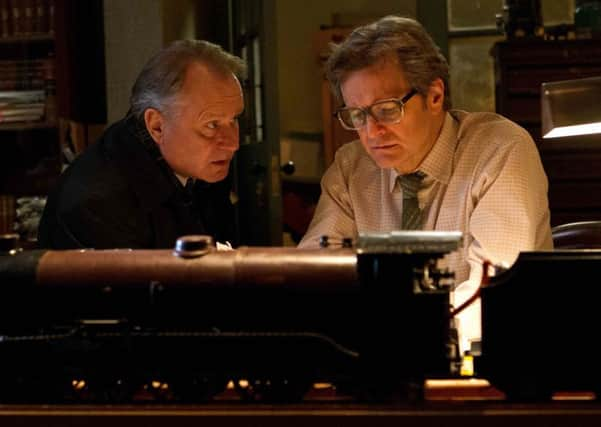Former enemies find a way to forgive and forget


ARGUABLY the worst experience in the life of Eric Lomax led, many years later, to the thing that was to give him peace of mind.
Lomax had a life of three defined parts. In the first he went from innocence to shocked acceptance of man’s cruelty to man. In the second he almost drowned beneath a cloying combination of post-traumatic stress, depression and overwhelming hatred. And in the third he found peace, contentment and catharsis with an unlikely ally.
Advertisement
Hide AdAdvertisement
Hide AdLomax was a 22-year-old officer in the Royal Corps of Signals when he was among 100,000 men captured by the Japanese at the fall of Singapore in February 1942. He spent the remainder of the war in a prisoner-of-war camp.
But, more importantly, he experienced the horrors of life as a slave labourer on what became known as the Burma-Siam death railway.
During his captivity Lomax was one of a band of men who constructed a rudimentary radio receiver to listen to far-off reports of the Allies’ progress in the war. When it was discovered he and his comrades were tortured and beaten.
The memories of his treatment at the hands of the enemy – and, in particular, a Kempeitai (Japanese military police) interrogator named Takashi Nagase – haunted Lomax for the rest of his life. He harboured dark thoughts of murdering his tormentor.
Advertisement
Hide AdAdvertisement
Hide AdIn the mid-1980s he discovered his nemesis was still alive. What Lomax didn’t know was that Nagase had attempted to atone for his actions during the war by building a Buddhist temple near the railway bridge that was immortalised in Pierre Boule’s novel The Bridge on the River Kwai.
The two met and, amazingly, Lomax was able to forgive the man who had caused him so much physical, mental and emotional pain. In 1995 they both featured in a documentary, Enemy, My Friend? Previously there was a TV film in the Eighties.
Now, after 14 years of production, comes a movie starring Colin Firth, Nicole Kidman and Jeremy Irvine. Nagase is played by the Japanese star Hiroyuki Sanada.
One of the producers of The Railway Man, a quasi biopic based on Lomax’s memoir, is co-writer Andy Paterson.
Advertisement
Hide AdAdvertisement
Hide Ad“The book was so beautifully written,” he recalls. “It captured the voice of a man who told such a shocking story – such an epic story. To find a cinematic way of going beyond what was in the book was quite a challenge.”
Paterson and co-writer Frank Cottrell Boyce were aware of the sustained beatings Lomax had endured – 900 blows in six hours that left no part of his upper body unbruised.
Tellingly, in all their time together Lomax could never articulate how and why he was able to reconcile with Nagase and forgive him.
“We said ‘We’ve seen you meet Mr Nagase, but what happened? How can you go from revenge to forgiveness?’ We completely believed that he wanted to kill this man and Eric couldn’t really explain it to us. He’d say ‘Somehow the pain just went away’.
Advertisement
Hide AdAdvertisement
Hide Ad“Or he’d suddenly say to you ‘I’d assumed that I would never be happy again’.
“He went though 30, 40 years of really being a very messed up man and so he was surprised to be happy. It was an extraordinary thing to try and capture.”
Lomax’s happiness came courtesy of his second marriage to Patti, a woman 17 years his junior.
It was she who made the first move in putting her husband in touch with Nagase. Maybe she recognised what the filmmakers saw: that he had undergone a sea change.
Advertisement
Hide AdAdvertisement
Hide Ad“Nagase made himself very, very unpopular in Japan by constantly trying to get the Government to accept that terrible things had been done and take some kind of responsibility,” says Paterson.
“An awful lot of the Japanese who were there were suffering their own horrors.
“If you didn’t do what you were told to do in the Japanese army, then reprisals would be taken against your family.
“It wasn’t just a simple bit of indoctrination. Nagase became the focus of Eric’s hatred because in that interrogation room the thugs who were doing the really physical stuff… you could write them off as animals. But this little man in front of him was an educated human being. He knew what he was doing.
Advertisement
Hide AdAdvertisement
Hide Ad“Nagase was witness to an awful lot of very terrible things. And so he tried to do something after the war to make up for that. A lot of people will not separate those two things: if you were there you were part of it [and] you should have done something about it. It’s an age-old question.
“He’s pretty unique and certainly not typical.”
Both men are now dead. Eric Lomax died in October 2012, aged 93. Takashi Nagase preceded him in June 2011.
In their passing some kind of a line may be drawn under the terrible events that took place on the railway of death.
But one suspects that, for them, the war ended when they met all those years later.
Time had washed away their pain.
On the track to reconciliation
Advertisement
Hide AdAdvertisement
Hide AdOn its publication in 1996 The Railway Man won the NCR Book Award and the J R Ackerley Prize for Autobiography.
The newly released film, based on the book, stars Colin Firth as the older Eric with Jeremy Irvine as his younger self.
Lomax was previously played by John Hurt in the film Prisoners in Time in 1985.
Takashi Nagase published his own memoir Crosses and Tigers.
Nagase has also previously been depicted in 2001’s To End All Wars, a film based on another memoir of the death railway by Ernest Gordon.
Railway Man is on general release now.